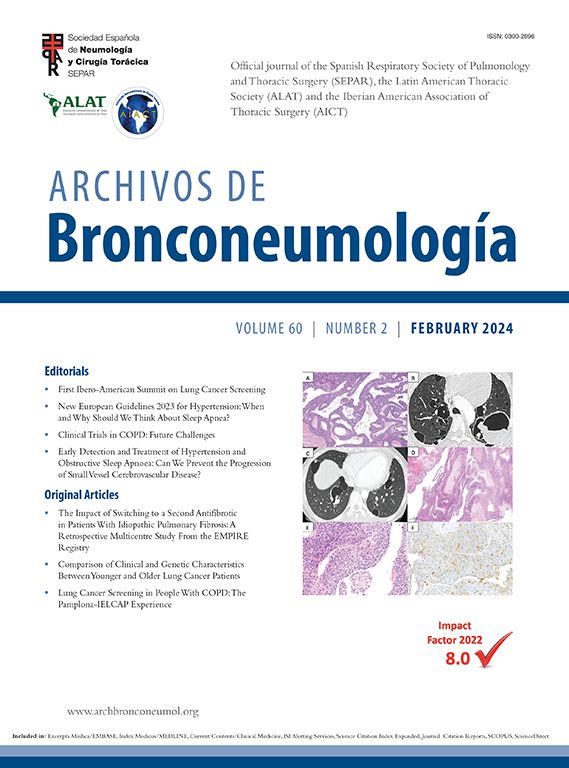社区获得性肺炎多微生物感染相关的危险因素和结果。
IF 9.2
3区 医学
Q1 RESPIRATORY SYSTEM
引用次数: 0
摘要
背景:多微生物肺炎是临床医生关注的问题,因为它与疾病严重程度增加有关。确定多微生物性肺炎的患病率并确定其病因风险增加的患者对CAP患者的管理很重要。在这里,我们描述了成年CAP住院患者的临床特征和结局,并确定了与多微生物肺炎相关的危险因素,特别是与30天死亡率相关的危险因素。方法:前瞻性收集5114例连续住院的成人CAP患者资料,进行现实回顾性研究;1703例患者有明确的病因。结果:14%具有明确微生物病原学的CAP患者存在多微生物感染(病房患者64%,ICU患者28%)。最常见的多微生物感染为:肺炎链球菌+呼吸道病毒(32%)、肺炎链球菌+流感嗜血杆菌(7%)和肺炎链球菌+金黄色葡萄球菌(7%)。在多微生物病因组中,不适当的初始抗菌治疗比单微生物病因组更常见(14%比7%,p=0.001)。多微生物组的住院死亡率(12%比7%,p=0.012)、30天死亡率(11%比6%,p=0.008)和1年死亡率(16%比8%,p=0.001)更高。在多变量分析中,多叶性肺炎(OR 1.34, 95% CI 1.00-1.80)是多微生物病因学的独立危险因素,而发热(OR 0.59, 95% CI 0.43-0.80)与该疾病的较低风险独立相关。在多变量分析中,多微生物感染是30天死亡率的独立预测因子(HR 1.83, 95% CI 1.17-2.87;p = 0.008)。结论:多微生物感染与CAP住院成人的不良预后有关,特别是患有慢性合并症的老年患者。多微生物感染是30天死亡率的危险因素。本文章由计算机程序翻译,如有差异,请以英文原文为准。

Risk Factors and Outcomes Associated With Polymicrobial Infection in Community-Acquired Pneumonia
Background
Polymicrobial pneumonia is a concern for clinicians due to its association with increased disease severity. Determining the prevalence of polymicrobial pneumonia and identifying patients who have an increased risk of this aetiology is important for the management of CAP patients. Here we describe the clinical characteristics and outcomes of adult hospitalized patients with CAP, and identify the risk factors related to polymicrobial pneumonia and specifically to 30-day mortality.
Methods
Real-life retrospective study from a prospectively collected data including 5114 consecutive adult patients hospitalized with CAP; 1703 patients had an established aetiology.
Results
Polymicrobial infection was present in 14% of the CAP patients with defined microbial aetiology (64% of ward patients and 28% of ICU patients). The most frequent polymicrobial infections were: Streptococcus pneumoniae + respiratory virus (32%), S. pneumoniae + Haemophilus influenzae (7%) and S. pneumoniae + Staphylococcus aureus (7%). Inappropriate initial antimicrobial treatment was more frequent in the polymicrobial aetiology group than in the monomicrobial aetiology group (14% vs. 7%, p = 0.001). In-hospital (12% vs. 7%, p = 0.012), 30-day (11% vs. 6%, p = 0.008) and 1-year mortality (16% vs. 8%, p = 0.001) were higher in the polymicrobial group. Multilobar pneumonia (OR 1.34, 95% CI 1.00–1.80) was an independent risk factor for polymicrobial aetiology in the multivariable analysis, while fever (OR 0.59, 95% CI 0.43–0.80) was independently associated with a lower risk for this condition. Polymicrobial infection was an independent predictor of 30-day mortality in the multivariable analysis (HR 1.83, 95% CI 1.17–2.87; p = 0.008).
Conclusions
Polymicrobial infection was related to poor outcomes in adults hospitalized with CAP, especially in elderly patients with chronic comorbidities. Polymicrobial infection was a risk factor for 30-day mortality.
求助全文
通过发布文献求助,成功后即可免费获取论文全文。
去求助
来源期刊

Archivos De Bronconeumologia
Medicine-Pulmonary and Respiratory Medicine
CiteScore
3.50
自引率
17.50%
发文量
330
审稿时长
14 days
期刊介绍:
Archivos de Bronconeumologia is a scientific journal that specializes in publishing prospective original research articles focusing on various aspects of respiratory diseases, including epidemiology, pathophysiology, clinical practice, surgery, and basic investigation. Additionally, the journal features other types of articles such as reviews, editorials, special articles of interest to the society and editorial board, scientific letters, letters to the editor, and clinical images. Published monthly, the journal comprises 12 regular issues along with occasional supplements containing articles from different sections.
All manuscripts submitted to the journal undergo rigorous evaluation by the editors and are subjected to expert peer review. The editorial team, led by the Editor and/or an Associate Editor, manages the peer-review process. Archivos de Bronconeumologia is published monthly in English, facilitating broad dissemination of the latest research findings in the field.
 求助内容:
求助内容: 应助结果提醒方式:
应助结果提醒方式:


